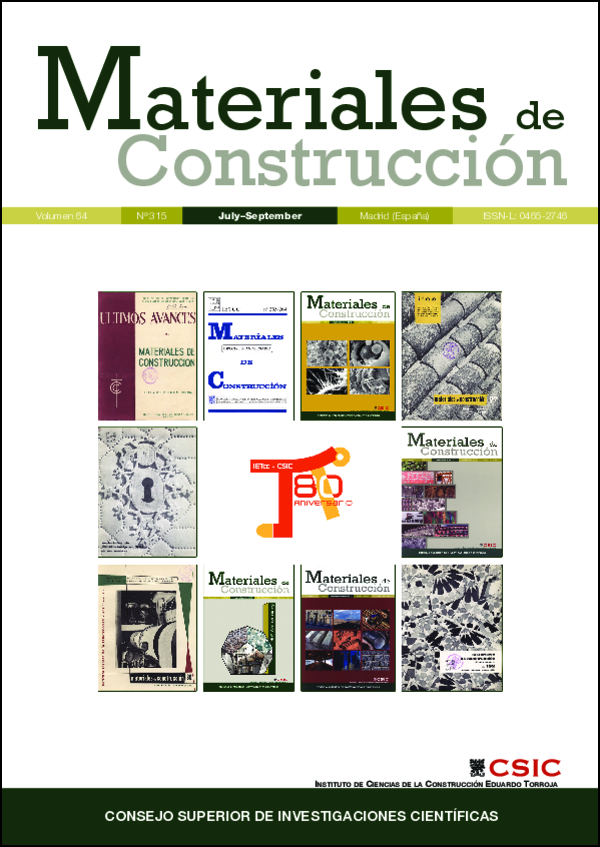Efecto de la granulometría de los áridos en la permeabilidad al aire del hormigón
DOI:
https://doi.org/10.3989/mc.2014.07213Palabras clave:
Permeabilidad al aire, gradación de los áridos, durabilidad del hormigónResumen
Se han encontrado una gran cantidad de problemas de durabilidad de estructuras de hormigón relacionados con la penetración de agentes agresivos externos (es decir, penetración de cloruros, ataque por sulfatos, carbonatación, hielo-deshielo, etc.). El coeficiente de permeabilidad al aire se utiliza como una herramienta eficaz para estimar la durabilidad potencial de las estructuras de hormigón debido a su relación directa con su microestructura y contenido de humedad. Se discute el efecto de la gradación de los áridos y relación agua/cemento en el coeficiente de permeabilidad al aire. Con áridos más finos que gruesos, el resultado es más beneficioso, lo que se atribuye a que la arena forma un esqueleto más denso. Con áridos más finos, al aumentar la relación agua/cemento, disminuye la permeabilidad al aire; pero con áridos más gruesos se ha observado lo contrario. Cuando se pre-acondiciona de 20 °C a 60 °C, se produce un aumento del Dair del 40–80%.
Descargas
Citas
Hall, C. (1989) Water sorptivity of mortars and concretes: a review. Mag. Concr. Res. 41 [147], 51–61. http://dx.doi.org/10.1680/macr.1989.41.147.51
Pihlajavaara, S.E.; Paroll, H. (1975) On the Correlation between Permeability Properties and Strength of Concrete. Cem. Concr. Res. 5 [4], 321–328. http://dx.doi.org/10.1016/0008-8846(75)90088-5
Soongswang, P.; Tia, M.; Bloomquist, D. (1991) Factors affecting the strength and permeability of concrete made with porous limestone. ACI Mat. J. 88 [4], 400–406.
Samaha, H.R.; Hover, K.C. (1992) Influence of microcracking on the mass transport properties of concrete". ACI Mat. J. 89 [4], 416–424.
Mills, R.H. (1987) Gas and Water Permeability of Concrete for reactor Building – Small Specimens. Research Report. INFO-0188-1, Atomic Energy Control Board and University of Toronto. p. 126.
Young, F.J. (1988) A review of the pore structure of cement paste and concrete and its influence on permeability, in: D. Whiting and A. Walitt (Eds.), SP-108: Permeability of Concrete, American Concrete Institute, Detroit, Michigan, 1–18.
Wong, H.S.; Pappas, A.M.; Zimmerman, R.W.; Buenfeld, N.R. (2011) Effect of entrained air voids on the microstructure and mass transport properties of concrete. Cem. Concr. Res. 41 [10], 1067–1077. http://dx.doi.org/10.1016/j.cemconres.2011.06.013
Scrivener, K.L.; Gartner, E.M. (1988) Microstructural Gradients in cement paste around aggregate particles, in: S. Mindness, S.P. Shah (Eds.), Bonding in Cementitious Composites, Mat. Res. Soc. Symp. Proc., 114, Cambridge, 77–86.
Scrivener, K.L.; Crumbie, A.K.; Pratt, P.L. (1988) A study of the Interfacial region between cement paste and aggregate in concrete, in: S. Mindness, S.P. Shah (Eds.), Bonding in Cementitious Composites, Mat. Res. Soc. Symp. Proc., 114, Cambridge, 87–88.
Choinska, M.; Khelidj, A.; Chatzigeorgiou, G.; Pijaudier-Cabot, G. (2007) Effects and interactions of temperature and stress-level related damage on permeability of concrete. Cem. Concr. Res. 37 [1], 79–88. http://dx.doi.org/10.1016/j.cemconres.2006.09.015
Valenza II, J.J.; Thomas, J.J. (2012) Permeability and elastic modulus of cement paste as a function of curing temperature. Cem. Concr. Res. 42 [2], 440–446. http://dx.doi.org/10.1016/j.cemconres.2011.11.012
EN 197-1:2011, Cement. Part 1: Composition, specifications and conformity criteria for common cement.
Sanjuán, M.A.; Argiz, C. (2012) The new European standard on specifications for common cements UNE-EN 197-1:2011. Mater. Construcc. 62 [307], 425–430. http://dx.doi.org/10.3989/mc.2012.07711
Sanjuán, M.A.; Muñoz-Martialay, R. (1995) Influence of the age on air permeability of concrete. J. Mater. Sci. 30 [22], 5657–5662. http://dx.doi.org/10.1007/BF00356701
Sanjuán, M.A.; Muñoz-Martialay, R. (1996) Oven-drying as preconditioning method for air permeability test on concrete. Materials Letters 27 [4–5], 263–268. http://dx.doi.org/10.1016/0167-577X(95)00283-9
Neville, A.M.; Brooks, J.J. (2010) Concrete Technology, p. 464, 2nd revised edition, Transatlantic Publishers Group Ltd., London.
Basheer, L.; Basheer, P.A.M.; Long, A.E. (2005) Influence of coarse aggregate on the permeation, durability and the microstructure characteristics of ordinary Portland cement concrete. Construct. Build. Mat. 19 [9], 682–690. http://dx.doi.org/10.1016/j.conbuildmat.2005.02.022
Cabrera, O. A.; Traversa, L. P.; Ortega, N. F. (2011) Effect of crushed sand on mortar and concrete rheology. Mater. Construcc. 61 [303], 401–416. http://dx.doi.org/10.3989/mc.2011.55609
Martín-Morales, M.; Sánchez-Roldán, Z.; Zamorano, M.; Valverde-Palacios, I. (2013) Size grading methods to characterize construction and demolition waste for its use in structural concrete. Mater. Construcc. 63 [310], 235–249. http://dx.doi.org/10.3989/mc.2013.mc.06511
Medina, C.; Juan, A.; Frías, M.; Sánchez de Rojas, M. I.; Morán, J. Mª.; Guerra, M. I. (2011) Characterization of concrete made with recycled aggregate from ceramic sanitary ware. Mater. Construcc. 61 [304], 533–546. http://dx.doi.org/10.3989/mc.2011.59710
Bermejo, E.B.; Moragues, A.; Gálvez, J.C.; Fernández Cánovas, M. (2010) Permeability and pore size distribution in medium strength self-compacting concrete. Mater. Construcc. 60 [299], 37–51.
Bhargava, A.; Banthia, N. (2008) Permeability of concrete with fiber reinforcement and service life predictions". RILEM, Materials and Structures 41 [2], 363–372. http://dx.doi.org/10.1617/s11527-007-9249-6
Lafhaj, Z.; Richard, G.; Kaczmarek, M.; Skoczylas, F. (2007) Experimental determination of intrinsic permeability of limestone and concrete: Comparison between in situ and laboratory results. Building and Environment 42 [8], 3042–3050. http://dx.doi.org/10.1016/j.buildenv.2006.07.039
Pereira, V.M.; Carvalho, E.; Bardella, P.S.; Camarini. G. (2008) Fluid-dynamic analysis of the flow in air permeability measurement of mortars prepared with blast-slag furnace Portland cement. Cerâmica 54 [330] 160–166.
Paulini, P. (2010) A laboratory and on-site test method for air permeability of concrete. 2nd International Symposium on Service Life Design for Infrastructure. 4–6 October 2010, Delft, The Nederlands, pp. 995–1002.
Publicado
Cómo citar
Número
Sección
Licencia
Derechos de autor 2014 Consejo Superior de Investigaciones Científicas (CSIC)

Esta obra está bajo una licencia internacional Creative Commons Atribución 4.0.
© CSIC. Los originales publicados en las ediciones impresa y electrónica de esta Revista son propiedad del Consejo Superior de Investigaciones Científicas, siendo necesario citar la procedencia en cualquier reproducción parcial o total.
Salvo indicación contraria, todos los contenidos de la edición electrónica se distribuyen bajo una licencia de uso y distribución “Creative Commons Reconocimiento 4.0 Internacional ” (CC BY 4.0). Consulte la versión informativa y el texto legal de la licencia. Esta circunstancia ha de hacerse constar expresamente de esta forma cuando sea necesario.
No se autoriza el depósito en repositorios, páginas web personales o similares de cualquier otra versión distinta a la publicada por el editor.
















